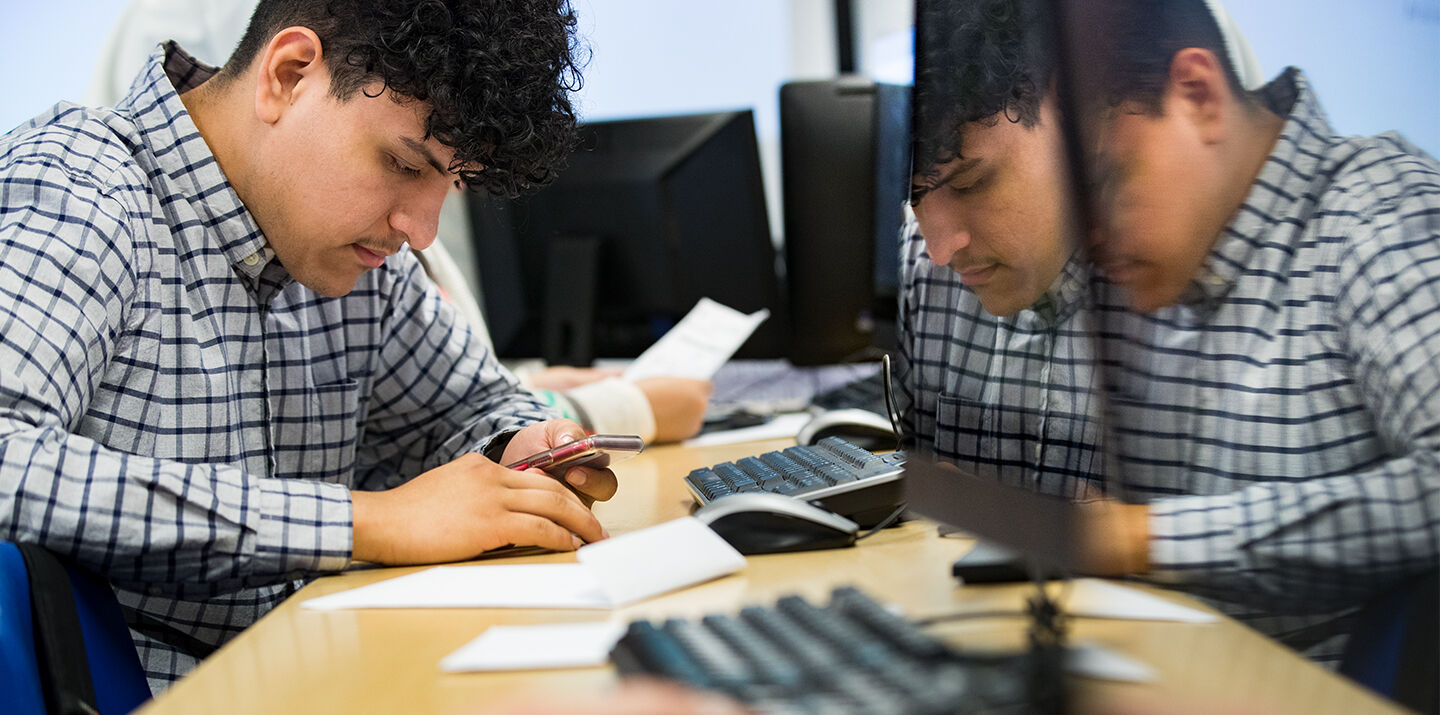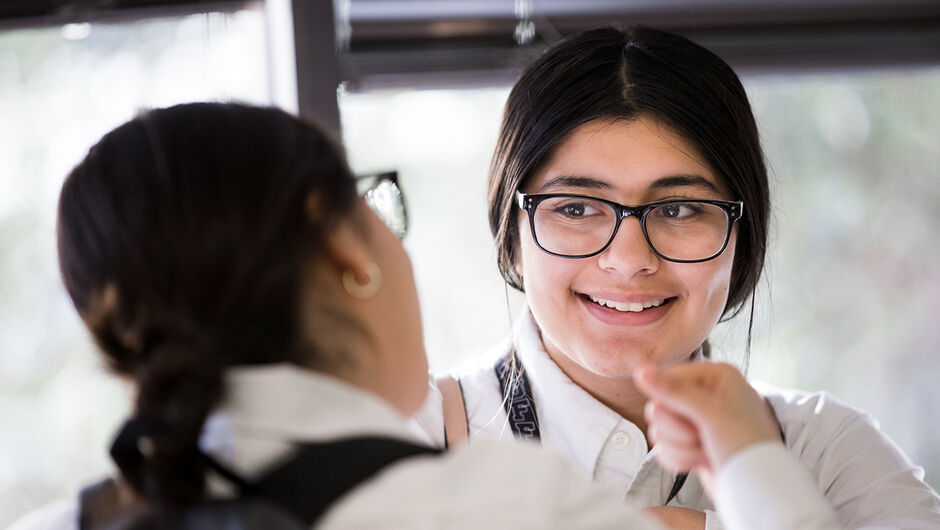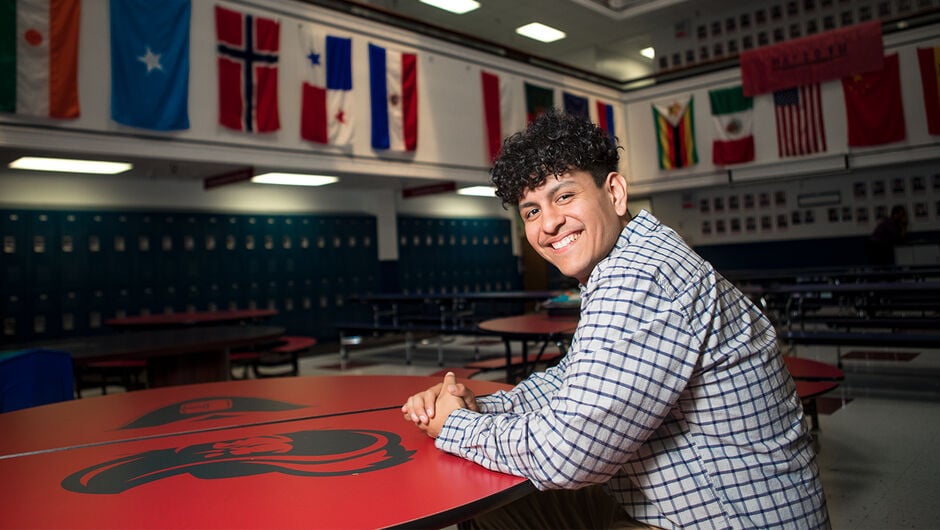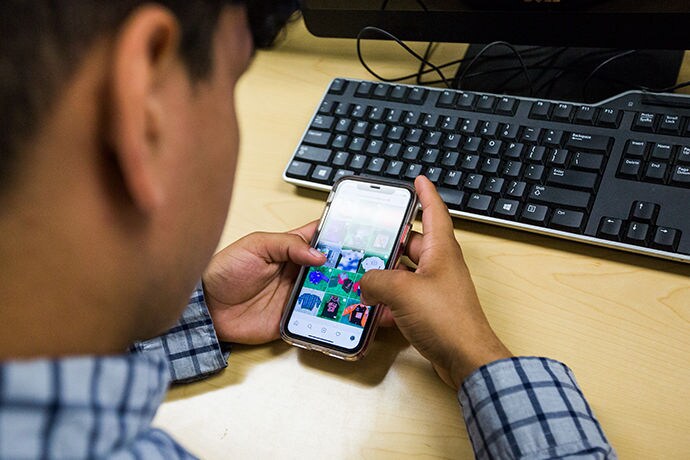
IRL: Hanging w/ Gen Smartphone
More than a way to send messages or make calls, smartphones and the apps that live inside of them are extensions of students’ personalities and lives. Dive into the digital lives of students today.
Libiri Cornejo, 17, and Esteban Lopez, 18, sat across the room from each other in a Houston-area classroom one day this past spring. It was their first period class, Senior Seminar, and students sat in their seats hustling to complete college applications and scholarship essays.
From some other place in their school building, a friend texted Libiri and asked her to print out study materials for government class, since Libiri was in a classroom with a printer. Esteban, who already has plans to study nursing at a local community college in the fall, was planning the next post for his Instagram business profile.
Libiri and Esteban are just 2 of the 65 million people in the U.S. who make up Generation Z. For them, life is about more than what is happening in their physical space. It’s also about everything they are connected to digitally through their smartphones.
Both born in 2001, they never knew a time before the internet, and they’re too young to recall the first iPhone rollout. Like 95% of U.S. teens who have access to smartphones, they navigate school, home, work, and even sleep with one earbud in, one earbud out.
Experts in virtually every relevant field are studying the interplay of teens and technology, but teachers in the classroom today don’t have the luxury of waiting for conclusive guidance. What’s happening at Libiri and Esteban’s high school, YES Prep Brays Oaks, is what’s happening in high schools across America. Students are interacting with the world digitally in ways teachers can’t fully see and don’t intuitively understand.
Educators are faced with competing realities: Smartphones are incredibly powerful minicomputers that provide access to ever more sophisticated tools to support learning—from collaboration platforms to apps allowing students to signal anxiety or emotional distress. And yet at the same time, phones are engineered to steal focus: yours, mine, students’.
Media teacher Trent Barnes (Miami-Dade ’08), at YES Prep Brays Oaks, has seen smartphones transform his students’ learning. For class vlogging projects, kids in Barnes’s class have prepared for real media jobs by learning how to create, edit and post videos to the web, all by using just their phones. He balances that experience with lesson plans about social media and promoting yourself professionally online. Barnes also regularly taps into social media as a way of connecting the community at YES Prep, creating Instagram boomerang videos with kids jumping in the air and waving the banners of their future colleges.
Yet the struggle to mediate phone use is real. A 2016 Gallup Poll of more than 900,000 students nationwide revealed that by 10th grade, barely a third of students feel engaged in school. How can educators make sure phones are a defense against boredom, instead of boredom’s best defense? And with technology where it’s at today, is that even possible?
Barnes is part of a school team that recognizes there’s no way to work through these urgent questions without understanding more deeply their students’ relationships with phones, and honestly reflecting on what that means for student learning. He began this school year by instituting an “open phone policy” in all his classes, including Yearbook (which is where he introduced me to his students, Libiri and Esteban).
Then Barnes and the school team went a step further. They agreed to let a One Day reporter learn directly from the experts who are seldom consulted: students. I followed Libiri and Esteban in the last quarter of their senior year to observe what they did with their phones all day, and to ask them about that.
For part of a school week, I got to sit beside these seniors at lunch and walk hurriedly beside them as they went from class to class (up and down a five-story building). When they pulled out their phones, I saw what they were up to.
Neither student is a tech super user. They’re just hardworking kids who have many responsibilities, and who are eagerly looking forward to completing their last semester before college and the military (for Libiri) and a service-oriented career in the health field (for Esteban). As I entered into this high school experience that was so radically different from mine of 14 years ago, I was eager to learn from them directly what it looks and feels like to be constantly connected, and what outsiders (we adults) might be getting wrong about it all.
These are Libiri’s and Esteban’s digital diaries.

Libiri
7:39 a.m.
Libiri texts: “Hey, I woke up a few min ago but had to rush and get ready, sorry I didn’t pick up”
Libiri texts again: “I’m going to be late by the way, my Uber is taking forever”
Pew Research shows that 44% of teens, like Libiri, check their phones the moment they wake up. On this morning, Libiri finds two missed calls and a message from this reporter, who is waiting for her outside her Southwest Houston apartment. Research shows I was right to follow my call with a text. The company Text Request estimates that only 20% of phone users, regardless of age, will answer an unexpected call, but most texts are read within five seconds of being received.
Libiri didn’t send me to voicemail just to avoid an awkward conversation. Because she works after school until midnight, her morning routine can be rough. And because her mom goes to work earlier, she has to get her 13-year-old brother to school. The school bus stops outside her apartment complex, but on a rushed day like this one, she orders an Uber (the app lives in a folder on her iPhone labeled “Needs”).
8:38 a.m.
Text to Libiri: How much you need to pass [science]?
Another text to Libiri: Hey can you do me a favor I need you to print out benchmark can you print it out for me rn
While she texts with her friend about the final grades needed to pass final-semester courses, Libiri opens a Google folder with the file her friend needs and hits print. Last-minute file sending, snapping photos of notes from a friend, or snapping what teachers have written on the board has Libiri frequently pulling out her phone. “It makes things easier for me in school, honestly,” she says.
Experts are still deciding. A 2017 study on cognitive capacity by researchers at the University of Chicago found that simply the presence of a phone, even flipped over or turned off, commands attention, distracting users from all else. It’s a quandary. Still, research shows that more than 90% of district administrators say students’ access supports learning, and 68% of principals allow periodic access to personal devices at school.
Around the world, educators are testing different options. In France, this school year marks the first that cell phone usage is banned for all students through ninth grade. In Ontario, Canada, phones will be banned in all classrooms next year except when they’re specifically used in a lesson, for medical needs, or for students with special needs.
8:43 a.m.
Posing
Classmates seated behind Libiri ask her to pose with them for a photo. She squats between them, tilts her head for the shot, and smiles. The filter on the Snapchat app turns everyone’s faces bright, elongating their eyelashes and adding sparkles. Then she grabs her phone and heads to a quiet corner in the classroom to call a San Antonio college admissions office. (Turns out only a live voice can help her find the login information for her student financial aid account.)
About 41% of U.S. teens are estimated to have Snapchat profiles. Snapchat self-reports that users open the app more than 20 times a day and spend an average of 30 minutes snapping, totaling 3 billion daily snaps. During one school day, I watched Libiri access her own or a friend’s Snapchat account 15 times, mostly in the hallway or during downtime, each time opening the app for less than a minute to send a direct message or view a photo.
Psychology professor Jean Twenge, a scholar of what she calls the “iGeneration,” found that five hours or more of device exposure in a day correlated with a 71% increased likelihood that a teen would experience depression. What’s documented on Libiri’s social media channels, however, looks like a transformation from a shy freshman who hid her face with side-swept bangs to the bubbly senior she is now, posing with friends at after-school hangouts.
Libiri brushes off adult worries about teenagers spending too much time on their phones. She could give hers up without much impact, she says. “I’ll have some more time to hang out with people without it, probably. But I’m not on it that much anyway, to be honest.”
11:00 a.m.
Typing: “critics of Haruki Murakami”
Libiri sits down at a computer for her fourth period yearbook class with Trent Barnes. The first thing she does is connect her iPhone to the computer tower’s USB port in front of her to charge up her device. She uses the computer to search through Google Drive for a document, but after a few minutes, she grows frustrated and opens the app on her still-charging phone. It sits inside a folder labeled “School” with other apps including GroupMe, Photomath, GradePro, and Classroom.
“I’m so used to my phone, and I don’t really use a computer at home,” Libiri says. “Whenever I do look at my work on a big computer screen, I’m just like ‘Eh, no, let’s go back to the phone.’” Her web search for criticisms of Sputnik Sweetheart yields results, so with her eye on the screen in front of her and her fingers on her phone’s keyboard, she types a few paragraphs of her report.
12:13 p.m.
“Should I AirDrop it?”
Libiri turns her phone face down so she can study. Then, a few minutes later, a friend taps her on the shoulder. She’s been missing some must-see memes. “¡Estoy concentrando en mi trabajo!” she says, but she’s smiling, too. She checks her phone and comes across a photo of a friend that makes her laugh. “Should I AirDrop it?” she asks her neighbor, who gives her the go-ahead. A classmate stands up across the room and announces she’s getting too many messages today so she’s turning off her AirDrop.
Because phones are her instant connection to friends, Libiri says she can isolate herself instantly too. “I went a whole day without [my phone] last year,” she says. “I was being really moody.”
The solitude that Libiri considers “moody” is actually healthy for a teen’s development, as long as it’s a choice she makes and not something forced upon her as a punishment or as the result of social anxiety. That was one of the findings in a recent study of solitude out of the University of California, Santa Cruz, and Wilmington College. With 45% of teens reporting being online almost constantly, returning from solitude is as easy as flipping the phone faceup.

1:09 p.m.
Opening Google Drive
At lunch, Libiri finds a table with her friends. Her phone mostly stays in her pocket except when she pulls it out just to reassure herself that she did upload her latest draft of an English assignment to Google Drive.
Smartphone users let their devices work as extensions of their memory banks, according to “The Brain in Your Pocket,” a report out of the University of Waterloo, Canada. Researchers suspect that that kind of use, for things that brains once managed on their own, leads to less analytical thinking and what the report’s authors call a “meshing of mind and media,” the impacts of which are still unclear.
1:11 p.m.
Opening Photos app: “Wait till I show you this picture!”
Libiri pulls up a photo from her Photos app to show friends a picture of her incoming U.S. Army class. In the fall, Libiri will head to basic training in South Carolina while also taking online courses at a San Antonio college. She wants to study journalism and nursing, but dreams of becoming a firefighter, too. “My older brothers have all tried to join the military or go to college, but they haven’t had the opportunity, so I’m doing it for them and putting pride onto their names,” says Libiri.
On Instagram, Libiri uses the Stories Highlights feature to create a reel of moments from recruitment events. Her regular Instagram feed is mostly selfies with Snapchat filters adding dog ears or floating hearts. She has more than 500 followers, but as of late she only posts about once a week.
Even as adults wring their hands about teens’ rate of sharing photos, trends suggest a move in the opposite direction. A 2018 article from the Journal of Consumer Research described an ongoing shift in attitudes about smartphone photography. People are increasingly aware that a photo taken means a photo shared, the article says, leading to more angst and less pure enjoyment.
2:20 p.m.
Hitting play on Apple Music
For the first 15 minutes of English class, before continuing a unit on Hamlet, Libiri’s teacher gives students free time to work on upcoming projects. The teacher projects a message on the whiteboard: “Phones OK.” Libiri pulls up her latest Apple Music playlist: first track, Travis Scott’s “Can’t Stay.”
“I don’t listen to the words, I just listen to the beat to help me focus,” Libiri tells me as I sit alongside her.
Studies show students could do themselves a favor by turning the music off. A 2014 paper in the journal Applied Cognitive Psychology found that when studying, nothing beats silence. Researchers exposed test takers to different sound environments, and those who studied in silence outperformed those who studied with music. If music must be on, students would do best to choose something without lyrics.
2:45 p.m.
Reading a New York Times headline: “Sudan’s President Omar Hassan al-Bashir Is Ousted”
News teasers pop up all day on the sites Libiri visits. But as with advertisements, she mostly scrolls past them until she gets to a class that requires her to read and reflect about current events. She chooses the Sudan story. “It intrigued me as it spoke about the army,” Libiri wrote on her assignment.
Research shows that phones are the main way Americans consume news. When Libiri spots her teacher’s current events question about a scandal involving the mayor of Baltimore, she fills in the answers right away. “I heard about this one already,” she says. “I read about it on my phone.”
12:00 a.m.
Late-night phone call
Having had few breaks during her night shift at Taco Cabana, Libiri falls fast into bed when she returns home and jumps on a phone call with two friends. They plan a bike trip downtown and other almost-end-of-high-school activities. She falls asleep with the phone still on, her friends still chattering. One earbud in, one out.

Esteban
6:53 a.m.
Esteban answers Mom’s call
Before Esteban’s mom left for work this morning, a storm rolled through Houston, and homes across the city lost power. She calls while still on the road, to check in.
“Staying connected to family is the most important thing my phone allows me to do,” Esteban says. It’s the reason his parents gave him a phone. He was taking part in so many extracurriculars, like football, chess club, and volleyball, they needed a way to keep in touch. But parents, like kids and teachers, are still learning what’s OK when it comes to smartphone use during school time. Teachers everywhere have found themselves in the tricky position of managing parents’ texts, even phone calls, mid-lessons.
In more than 60% of American households, each available parent works outside the home. With Esteban’s parents’ workdays starting before the school day and ending long after, scheduling rides consumes part of his phone time. He recalls a time—the only time, he says—when his phone was taken away at school while he and his mom sorted out his pick-up time via text.
9:20 a.m.
Text from Esteban: “How much on the Coca Cola and mj Jersey”
While his teacher puts up a problem on the projector, Esteban takes a seat in the back of his second period precalculus class. He holds his head low and shoots a quick group text to his brother and sister about their Instagram business, Third Dimension. The three siblings started a business selling vintage clothing on their Instagram page earlier this year. They source their finds (D.A.R.E. T-shirts are sure sellers) on weekend trips to flea markets. With business booming, Esteban frequently finds himself multitasking. It’s easy to see how school and his entrepreneurial venture blend in his mind and in his actions—switching from solving for profit percentages to solving for x.
Normally, Esteban wouldn’t send text messages during class. But he worries that if he doesn’t text his siblings right away to work out a price, he might lose a buyer. Once it’s settled, he dives into precalculus.
11:24 a.m.
Pressing play on YouTube: “Three Cheetahs Vs Ostrich”
During some downtime, Esteban and his neighbors scoot close together to watch National Geographic videos. They start with “Pack of Wolves Hunt a Bison,” then click the next one to pop up, “Three Cheetahs Vs Ostrich.”
YouTube is Esteban’s favorite app and platform. He likes that it exposes him to the daily lives of people he might not otherwise meet—people in different countries, different professions, with different life experiences. And of course, the occasional Game of Thrones recap that shows up via YouTube’s “Up Next” algorithm.
Recent research has called YouTube’s algorithm into question, showing how it leads users to ever more extreme perspectives—a mainstream news story to outright hate speech in a casual succession of clicks. On this day, though, the transition to Game of Thrones from wolves hunting bison feels innocuous and logical. It encapsulates the challenge teachers face: When an app can be toxic in one moment and educational in the next, how do we teach kids (and ourselves) to be aware of the difference?
12:35 p.m.
In theater class, Esteban sits off to the side while the rest of his group runs lines for a short play. Because his part has little dialogue, he sneaks a few texts to his girlfriend. They fill the gaps between the five classes they already share.
1:05 p.m.
Opens SoundCloud app
At lunchtime, Esteban finds a counselor and gets permission to use his office to study for an upcoming science quiz. Esteban puts on his headphones and finds a Frank Ocean remix to listen to while reviewing a PowerPoint slide. “When it gets too loud and I can’t focus, or if I just don’t want to interact with people, listening to music or watching something on YouTube helps me focus,” he says.

6:30 p.m.
Photographing a new purchase
When Esteban shares with his Snapchat followers the photos of his new Marvel comics, he is proclaiming his style and upping his Snapchat game. Each time users snap a photo for followers, receive a photo, or send a message using the app, points are added to their accounts. Esteban’s point total after sharing his photo: 13,272. Nothing can be earned or won with the points, but the running tally is a way of showing who is current on the app. When a user doesn’t use the app for a while, Snapchat throws out a lure of bonus points.
It’s no surprise that digital spaces are shared spaces for teens like Esteban. Outside of school, 88% of teens report hanging out with friends online at least weekly, through social media, gaming, or apps like Facetime. Real human contact is still a thing, though—even for teens. About 77% of them report spending social time with friends—outside of school but in person—at least once every week.
10:07 p.m.
Posting to Instagram
Before he heads to bed, Esteban refreshes his business Instagram page and checks for new messages from customers. Tonight, he uploads a photo of a vintage Vince Carter jersey, shot against a green backdrop that he and his siblings bought to make their postings seem more official.
This is not just what Esteban does to make money; it’s how he projects his identity and his style. He had always thought his preference for ’90s clothes made him a bit of an outsider, until kids started asking him to hook them up.
It’s not surprising Esteban uses Instagram and not a webpage for business. That’s how he’s seen business get done for half his life.
By the time Esteban wakes up the next morning, six people have reacted to the jersey with a “like.” Before he heads to school, he stuffs a small gym bag with the day’s essentials: his copy of Hamlet to prep for the scene he’ll act out during English class, his study materials for the next science quiz, a black and red retro Fila jacket to deliver to a buyer, and, of course, his phone. He slides it into a side pocket and slips out the door, ready for the day.
Looking Ahead
As my reporting project came to a close, I checked back in with teachers and school leaders at YES Prep Brays Oaks. They get it as well as anyone: Educators must adapt to the growing role that phones play in students’ daily lives. And teachers and school leaders alike are charged with continuing to find innovative ways to use smartphones in the classroom while simultaneously teaching students how to use them efficiently and effectively. It’s about developing a plan for phone usage that aligns with the school’s values, they said. For YES Prep Brays Oaks, that means allowing phones in class next year under two conditions: when there’s active monitoring, and when it enhances research, feedback, presentation, or access to the curriculum.
And they’re as curious as I am: What will you do at your school?
Featured image: Esteban Lopez is a senior at YES Prep Brays Oaks in Houston and one of the 95% of American teens who own or have access to a smartphone. Photo by Marie D. De Jesús.
Sign up to receive articles like this in your inbox!
Thanks for signing up!
Content is loading...


